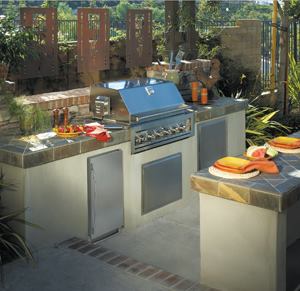General contractor and custom home builder Bowie Howard is keeping busy in the kitchen during the housing slump—very busy, in fact. For five years, the number of outdoor kitchens he has designed and installed for his Lubbock, Texas, homeowner customers has increased by 50 percent a year, even with prices ranging from $25,000 to $100,000 or more. “It’s not slowing down much,” says Howard, owner of Ironwood Builders. “If their next-door neighbor has one, they want to keep up with the Joneses.” Indeed, a record 17.4 million barbecue grills were shipped in 2007, up 13 percent from the year before, estimates the Hearth, Patio & Barbecue Association (HPBA) of Arlington, Va. And about 1.2 million Americans bought some components for an outdoor kitchen between 2007 and 2008, reports Standpoint, a Tucker, Ga.-based marketing research and consulting firm.
HPBA media and public relations manager Deidra Darsa splits the credit for the craze between a continuing national trend toward nesting and a heap of cool new features on outdoor grills and appliances. To be sure, the outdoor kitchen has morphed from the grill and picnic table on a patio configuration into one of the home’s most impressive rooms. It often showcases not only a grill but also cabinets, a cooktop and range, a refrigerator, granite or concrete countertops, an island, a huge TV set, a fire pit, some comfy furniture, and a stone or decorated-concrete floor.
“What we’ve seen since 9/11—and certainly more recently with the increase in fuel prices—is that people are looking to their backyards as a place to build their own resort area,” Darsa says. “Some remodelers are doing more outdoor rooms than indoor rooms.”
Across the Board. Al fresco entertaining is particularly popular with owners of high-end homes, says Pete Georgiadis, president of Kalamazoo Outdoor Gourmet, which sells top-of-the-line grills costing between $5,000 and $15,000, as well as stainless steel refrigerators, sinks, cabinets, wine chillers, lobster boils, and pizza ovens. “At $600,000 and above in the Sun Belt, every home has an outdoor cooking and entertainment area,” he says. Once you reach a certain level, “you wouldn’t consider not having an outdoor kitchen.” The popularity of outdoor kitchens extends far beyond the Sun Belt, he adds. “Sales on the high end of outdoor kitchens match wealth,” he says, noting the largest markets for his company’s products are in California, Connecticut, and New York. “It has more to do with being able to afford to buy something like this … than it does the weather.”
Indeed, Baldwin Park, Calif.-based Viking distributor Sues, Young & Brown sells more than 100 complete outdoor kitchens to Toronto-area homeowners every year. “They do everything they can to extend the season,” Georgiadis continues, so when the weather allows them to grill, “they do it almost every night. It’s a lifestyle choice.” Even in colder climates like Minnesota’s, patios, decks, and outdoor rooms “are becoming huge again,” says Rosemount, Minn.-based remodeler Steve Henjum. “People are trying to get more living space out of their house by going outside, and we’re marketing to that.”
While tricked-out backyards may be gracing mainly upscale homes, a wide range of options have made the outdoor kitchen trend equally feasible for more moderate abodes. Even owners with starter homes are adding on, beginning with simple—usually built-in—grills, and later incorporating extras such as outdoor-rated refrigerators; rust-resistant stainless steel cabinets; durable granite or concrete countertops; and weatherproof flat-screen TVs. “You don’t have to be a millionaire to have one of these kitchens,” confirms Howard Barshop, owner of Outdoor Kitchens of New York and New Jersey, who says he can install a grill, refrigerator, and 6-foot-long granite-and-stone island for around $6,000. “We can custom-make it to the person’s budget.”
In Their Element. Appliance manufacturers typically charge about 50 percent more for outdoor appliances than for indoor-only models. One reason: Outdoor-rated refrigerators feature stainless steel inside and out and on all sides, whereas indoor models generally have painted porcelain or plastic interiors and black sides and tops. What’s more, outdoor appliances often have thicker insulation, moisture barriers to protect against rain and humidity, and gaskets that can survive the sun’s intense ultraviolet rays.



